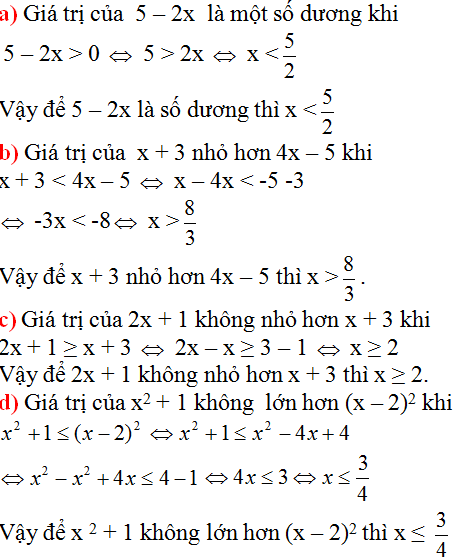Hãy nhập câu hỏi của bạn vào đây, nếu là tài khoản VIP, bạn sẽ được ưu tiên trả lời.

BÀI 1:
\(A=\left(x-10\right)^2+103\)
Có: \(\left(x-10\right)^2\ge0\forall x\)
=> \(A\ge103\)
DẤU "=" XẢY RA <=> \(\left(x-10\right)^2=0\Rightarrow x=10\)
\(B=\left(2x+1\right)^2-6\)
Có: \(\left(2x+1\right)^2\ge0\forall x\)
=> \(B\ge-6\)
DẤU "=" XẢY RA <=> \(\left(2x+1\right)^2=0\Leftrightarrow x=-\frac{1}{2}\)
BÀI 3:
a) \(A=y^4+y^3-y^2-2y-\left(y^4+y^3+y^2-2y^2-2y-2\right)\)
\(A=y^4+y^3-y^2-2y-y^4-y^3+y^2+2y+2\)
\(A=2\)
b) \(B=\left(2x\right)^3+3^3-8x^3+2\)
\(B=29\)
Bài 1.
A = x2 - 20x + 103
A = ( x2 - 20x + 100 ) + 3
A = ( x - 10 )2 + 3 ≥ 3 ∀ x
Đẳng thức xảy ra <=> x - 10 = 0 => x = 10
=> MinA = 3 <=> x = 10
B = 4x2 + 4x - 5
B = ( 4x2 + 4x + 1 ) - 6
B = ( 2x + 1 )2 - 6 ≥ -6 ∀ x
Đẳng thức xảy ra <=> 2x + 1 = 0 => x = -1/2
=> MinB = -6 <=> x = -1/2
Bài 2.
A = -x2 + 8x - 21
A = -x2 + 8x - 16 - 5
A = -( x2 - 8x + 16 ) - 5
A = -( x - 4 )2 - 5 ≤ -5 ∀ x
Đẳng thức xảy ra <=> x - 4 = 0 => x = 4
=> MaxA = -5 <=> x = 4
B = lỗi đề :>
Bài 3.
a) y( y3 + y2 - y - 2 ) - ( y2 - 2 )( y2 + y + 1 )
= y4 + y3 - y2 - 2y - ( y4 + y3 + y2 - 2y2 - 2y - 2 )
= y4 + y3 - y2 - 2y - y4 - y3 - y2 + 2y2 + 2y + 2
= 2 ( đpcm )
b) ( 2x + 3 )( 4x2 - 6x + 9 ) - 2( 4x3 - 1 )
= ( 2x )3 + 27 - 8x3 + 2
= 8x3 + 27 - 8x3 + 2
= 29 ( đpcm )

a) \(A=x^2-2x+5\)
\(=\left(x^2-2x+1\right)+4\)
\(=\left(x-1\right)^2+4\)
Vì \(\left(x-1\right)^2\ge0;\forall x\)
\(\Rightarrow\left(x-1\right)^2+4\ge0;\forall x\)
b) a sẽ làm tắt 1 vài bước nhé khi nào kiểm tra thì em làm theo mẫu a là được
\(B=4x^2+4x+11\)
\(=4\left(x^2+x+\frac{11}{4}\right)\)
\(=4\left(x^2+2.x.\frac{1}{2}+\frac{1}{4}-\frac{1}{4}+\frac{11}{4}\right)\)
\(=4\left[\left(x+\frac{1}{2}\right)^2+\frac{10}{4}\right]\)
\(=4\left(x+\frac{1}{2}\right)^2+10\ge10;\forall x\)
Dấu "=" xảy ra \(\Leftrightarrow\left(x+\frac{1}{2}\right)^2=0\)
\(\Leftrightarrow x=\frac{-1}{2}\)
Vậy \(B_{min}=10\Leftrightarrow x=\frac{-1}{2}\)
c) Tìm GTLN nhé
\(C=5-8x-x^2\)
\(=-x^2-2.x.4-16+16+5\)
\(=-\left(x+4\right)^2+21\)
Vì \(-\left(x+4\right)^2\le0;\forall x\)
\(\Rightarrow-\left(x+4\right)^2+21\le21;\forall x\)
Dấu "="xảy ra\(\Leftrightarrow\left(x+4\right)^2=0\)
\(\Leftrightarrow x=-4\)
Vậy\(C_{max}=21\Leftrightarrow x=-4\)
A = x2 - 2x + 5
= ( x2 - 2x + 1 ) + 4
= ( x - 1 )2 + 4 ≥ 4 > 0 ∀ x ( đpcm )
B = 4x2 + 4x + 11
= ( 4x2 + 4x + 1 ) + 10
= ( 2x + 1 )2 + 10 ≥ 10 ∀ x
Đẳng thức xảy ra <=> 2x + 1 = 0 => x = -1/2
=> MinB = 10 <=> x = -1/2
C = 5 - 8x - x2
= -( x2 + 8x + 16 ) + 21
= -( x + 4 )2 + 21 ≤ 21 ∀ x
Đẳng thức xảy ra <=> x + 4 = 0 => x = -4
=> MaxC = 21 <=> x = -4

\(A=x^2+3x+7\)
\(=x^2+2.1,5x+2,25+4,75\)
\(=\left(x+1,5\right)^2+4,75\ge4,75\)
Vậy \(A_{min}=4,75\Leftrightarrow x=-1,5\)
\(B=2x^2-8x\)
\(=2\left(x^2-4x\right)\)
\(=2\left(x^2-4x+4-4\right)\)
\(=2\left[\left(x-2\right)^2-4\right]\)
\(=2\left(x-2\right)^2-8\ge-8\)
Vậy \(B_{min}=-8\Leftrightarrow x=2\)

\(1,a,A=x^2-6x+25\)
\(=x^2-2.x.3+9-9+25\)
\(=\left(x-3\right)^2+16\)
Ta có :
\(\left(x-3\right)^2\ge0\)Với mọi x
\(\Rightarrow\left(x-3\right)^2+16\ge16\)
Hay \(A\ge16\)
\(\Rightarrow A_{min}=16\)
\(\Leftrightarrow x=3\)

a. \(P=x^2-2x+5=x^2-2x+1+4=\left(x-1\right)^2+4\)
vì \(\left(x-1\right)^2\ge0\) với mọi x
=> (x-1)^2 +4 \(\ge\) vợi mọi x
Pmin=4 <=> x-1=0 <=>x=1
1.
b)\(M=\left(x^2-x+\frac{1}{4}\right)+\left(y^2+6y+9\right)+\frac{3}{4}=\left(x-\frac{1}{2}\right)^2+\left(y+3\right)^2+\frac{3}{4}\ge\frac{3}{4}\)
Dấu = xảy ra \(\Leftrightarrow x-\frac{1}{2}=0\) và \(y+3=0\)
\(\Leftrightarrow x=\frac{1}{2}\) và \(y=-3\)
Vậy GTNN của M là \(\frac{3}{4}\Leftrightarrow x=\frac{1}{2}\)và \(y=-3\)

a) A= \(\frac{3x^2+5x-2}{3x^2-7x+2}=0\)
\(ĐK:3x^2-7x+2\ne0\)
\(\Leftrightarrow\orbr{\begin{cases}x\ne\frac{1}{3}\\x\ne2\end{cases}\left(^∗\right)}\)
=> 3x2 + 5x + 2 =0
<=> 3x2 + 3x + 2x +2 = 0
<=> 3x .( x + 1 ) + 2 .( x + 1 ) =0
<=> ( x + 1 )(3x + 2 ) =0
<=> \(\orbr{\begin{cases}x+1=0\\3x+2=0\end{cases}\Leftrightarrow\orbr{\begin{cases}x=-1\\x=\frac{-2}{3}\left(t/m\left(^∗\right)\right)\end{cases}}}\)
Vậy x = -2/3
b) \(B=\frac{2x^2+10x+12}{x^3-4x}=0\left(ĐK:x\ne0;x^2\ne4\Leftrightarrow x\ne0;x\ne\pm2\right)\)
<=> 2x2+ 10x + 12 = 0
<=> x2 + 5x+ 6 =0
<=> ( x + 2 ) ( x + 3 ) =0\(\Leftrightarrow\orbr{\begin{cases}x=-2\left(L\right)\\x=-3\left(t/m\right)\end{cases}}\)
Vậy x = -3
c)\(C=\frac{x^3+x^2-x-1}{x^3+2x-5}=0\) \(ĐK:x^3+2x-5\ne0\left(^∗\right)\)
<=> x3 + x2 -x -1 =0
<=> ( x - 1 )(x2 + 2x + 1 )
<=> ( x-1 ) (x+1)2 = 0
<=> \(\orbr{\begin{cases}x-1=0\\x+1=0\end{cases}\Leftrightarrow\orbr{\begin{cases}x=1\left(t/m\left(^∗\right)\right)\\x=-1\left(t/m\left(^∗\right)\right)\end{cases}}}\)
Vậy x = { 1 ; -1 }
a) A = \(\frac{3x^2+5x-2}{3x^2-7x+2}=0\) (ĐKXĐ: x khác 1/3, x khác 2)
<=> 3x^2 + 5x - 2 = 0
<=> (3x - 1)(x + 2) = 0
<=> 3x - 1 = 0 hoặc x + 2 = 0
<=> 3x = 1 hoặc x = -2
<=> x = 1/3 (ktm) hoặc x = -2 (tm)
=> x = -2
b) B = \(\frac{2x^2+10x+12}{x^3-4x}=0\) (ĐKXĐ: x khác 0, x khác +-2)
<=> \(\frac{2\left(x^2+5x+6\right)}{x\left(x^2-4\right)}=0\)
<=> \(\frac{2\left(x+2\right)\left(x+3\right)}{x\left(x-2\right)\left(x+2\right)}=0\)
<=> \(\frac{2\left(x+3\right)}{x\left(x-2\right)}=0\)
<=> 2(x + 3) = 0
<=> x + 3 = 0
<=> x = -3
c) C = \(\frac{x^3+x^2-x-1}{x^3+2x-5}=0\) (ĐKXĐ: x khác x^3 + 2x - 5)
<=> \(\frac{x^2\left(x+1\right)-\left(x+1\right)}{x^3+2x-5}=0\)
<=> \(\frac{\left(x+1\right)\left(x^2-1\right)}{x^3+2x-5}=0\)
<=> \(\frac{\left(x+1\right)\left(x-1\right)\left(x+1\right)}{x^3+2x-5}=0\)
<=> (x + 1)(x - 1) = 0
<=> x + 1 = 0 hoặc x - 1 = 0
<=> x = -1 hoặc x = 1

Bài 1:
\(2x^2+2x+1=2\left(x^2+x+\dfrac{1}{4}\right)+\dfrac{1}{2}=2\left(x+\dfrac{1}{2}\right)^2+\dfrac{1}{2}>0\Rightarrowđpcm\)Bài 2:
\(A=x^2-3x+5=\left(x^2-3x+\dfrac{9}{4}\right)+\dfrac{11}{4}=\left(x-\dfrac{3}{2}\right)^2+\dfrac{11}{4}\)Với mọi giá trị của x ta có:
\(\left(x-\dfrac{3}{2}\right)^2\ge0\Rightarrow\left(x-\dfrac{3}{2}\right)^2+\dfrac{11}{4}\ge\dfrac{11}{4}\)
Vậy GTNN của A là \(\dfrac{11}{4}\)
Để \(A=\dfrac{11}{4}\) thì \(x-\dfrac{3}{2}=0\Rightarrow x=\dfrac{3}{2}\)
b, \(B=\left(2x-1\right)^2+\left(x+2\right)^2=4x^2-4x+1+x^2+4x+4=5x^2+5=5\left(x^2+1\right)\)
Với mọi giá trị của x ta có:
\(x^2\ge0\Rightarrow x^2+1\ge1\Rightarrow5\left(x^2+1\right)\ge5\)
Vậy \(Min_B=5\)
Để B = 5 thì \(x^2=0\Rightarrow x=0\)
Bài 3:
\(A=4-x^2+2x=-\left(x^2-2x+1\right)+5=-\left(x-1\right)^2+5\)
Với mọi giá trị của x ta có:
\(\left(x-1\right)^2\ge0\Rightarrow-\left(x-1\right)^2\le0\Rightarrow-\left(x-1\right)^2+5\le5\)Vậy \(Max_A=5\)
Để A = 5 thì \(x-1=0\Rightarrow x=1\)
b, \(B=4x-x^2=4-\left(4-4x+x^2\right)=4-\left(2-x\right)^2\)
Với mọi giá trị của x ta có :
\(\left(2-x\right)^2\ge0\Rightarrow4-\left(2-x\right)^2\le4\)
Vậy \(Max_B=4\)
Để B = 4 thì \(2-x=0\Rightarrow x=2\)
Bài 1: CMR các biểu thức sau luôn dương với mọi giá trị của biểu thức
\(2x^2+2x+1\)
Ta có: \(2x^2>2x\forall x\) mà \(2x^2\ge0\)
\(\Rightarrow2x^2-2x\ge0\)
Vậy \(2x^2+2x+1\ge1\) (đpcm)